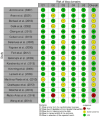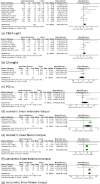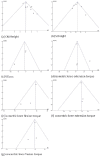Effects of Whole-Body Vibration on Exercise Performance among Athletes: A Systematic Review and Meta-Analysis of Randomized Controlled Trials
- PMID: 40463323
- PMCID: PMC12127932
- DOI: 10.5114/jhk/193514
Effects of Whole-Body Vibration on Exercise Performance among Athletes: A Systematic Review and Meta-Analysis of Randomized Controlled Trials
Abstract
Whole-body vibration (WBV), an intervention for enhancing athletes' exercise performance (muscle strength and power), is often used either as a supplement or an alternative to conventional training. The current systematic review and meta-analysis assessed the effects of WBV on exercise performance in athletes. PubMed, Embase, and Cochrane Library databases were searched for relevant randomized controlled trials published from database inception to April 2024. We analyzed three key components of exercise performance: muscle power (measured in terms of countermovement jump (CMJ) and squat jump (SJ) height), strength (measured in terms of isometric and concentric torque of the knee extensors and flexors), and aerobic cardiovascular endurance (measured in terms of maximal oxygen uptake (VO2max)). This review included 18 randomized controlled trials. WBV significantly improved concentric torque of the knee extensors and flexors, with effect sizes of 8.86 (95% confidence interval: 6.00 to 11.72; I2 = 0%; p < 0.00001) and 9.56 (95% confidence interval: 7.40 to 11.72; I2 = 0%; p < 0.00001), respectively. However, no significant changes were noted in the indicators of muscle power or cardiovascular endurance. Overall, our findings suggest that WBV interventions can enhance lower-limb strength in athletes. However, the quality of the evidence was low. To provide effective evidence-based guidance for WBV, future studies should consider participants' characteristics as well as intervention frequency, intensity, and duration in their analysis.
Keywords: aerobic endurance; power; sport performance; strength; youth athletes.
Copyright: © Academy of Physical Education in Katowice.
Conflict of interest statement
The authors declare no conflict of interest.
Figures
Similar articles
-
Effects of whole-body vibration on resistance training for untrained adults.J Sports Sci Med. 2011 Jun 1;10(2):328-37. eCollection 2011. J Sports Sci Med. 2011. PMID: 24149879 Free PMC article.
-
Long-term effect of whole body vibration training on jump height: meta-analysis.J Strength Cond Res. 2014 Jun;28(6):1739-50. doi: 10.1519/JSC.0000000000000320. J Strength Cond Res. 2014. PMID: 24276295
-
Impacts of Whole-Body Vibration on Muscle Strength, Power, and Endurance in Older Adults: A Systematic Review and Meta-Analysis.J Clin Med. 2023 Jul 3;12(13):4467. doi: 10.3390/jcm12134467. J Clin Med. 2023. PMID: 37445502 Free PMC article. Review.
-
The effects of whole-body vibration on muscle strength and power: a meta-analysis.J Musculoskelet Neuronal Interact. 2013 Sep;13(3):380-90. J Musculoskelet Neuronal Interact. 2013. PMID: 23989260
-
Effects of Plyometric Jump Training on Measures of Physical Fitness and Sport-Specific Performance of Water Sports Athletes: A Systematic Review with Meta-analysis.Sports Med Open. 2022 Aug 29;8(1):108. doi: 10.1186/s40798-022-00502-2. Sports Med Open. 2022. PMID: 36036301 Free PMC article.
References
-
- Al Masud, A., Shen, C.-L., & Chyu, M.-C. (2022). On the Optimal Whole-Body Vibration Protocol for Muscle Strength. Biomechanics, 2(4), 547–561. 10.3390/biomechanics2040043 - DOI
-
- Annino, G., Padua, E., Castagna, C., Di Salvo, V., Minichella, S., Tsarpela, O., Manzi, V., & D'Ottavio, S. (2007). Effect of Whole Body Vibration Training on Lower Limb Performance in Selected High-Level Ballet Students. Journal of Strength and Conditioning Research, 21(4), 1072–1076. 10.1519/r-18595.1 - DOI - PubMed
Publication types
LinkOut - more resources
Full Text Sources
Miscellaneous




